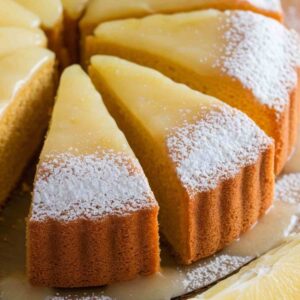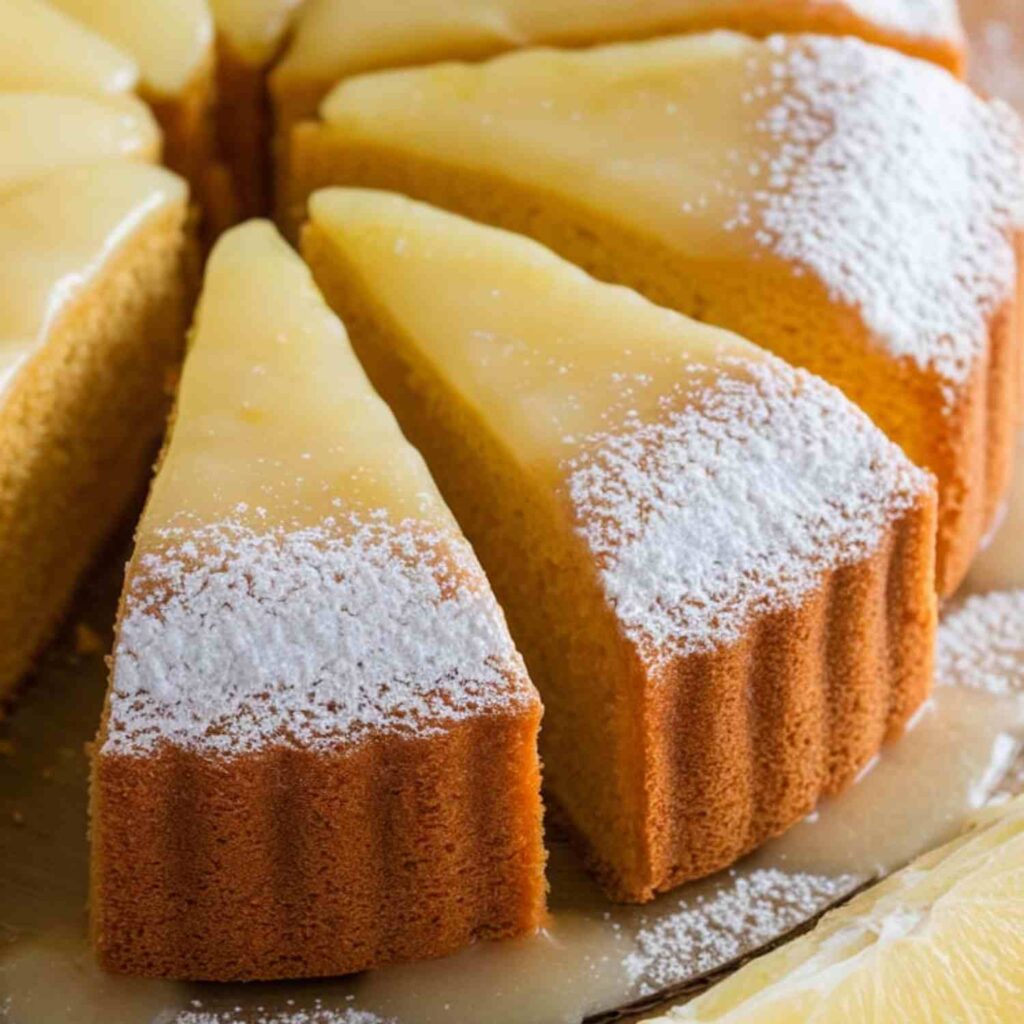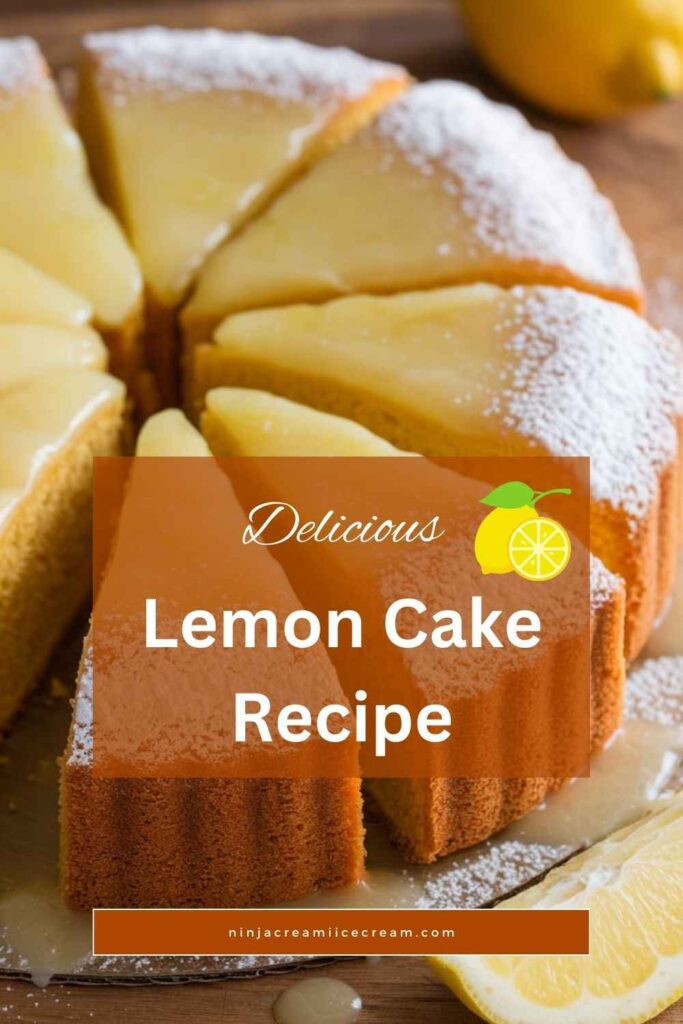Lemon Cake is a refreshing and zesty dessert that brings a burst of citrusy goodness in every bite. Its light and airy texture, paired with a tangy lemon flavor, makes it the perfect treat for any occasion—whether it’s a celebration or a casual afternoon indulgence. This cake is made with simple yet flavorful ingredients like fresh lemons, butter, and a touch of vanilla, which come together to create a moist, melt-in-your-mouth treat. The addition of a sweet and tangy lemon glaze on top elevates the flavor even further, making this Lemon Cake a true crowd-pleaser.
Disclosure: This post may contain affiliate links. As an Amazon Associate, I earn from qualifying purchases. Read more.
Lemon Cake Recipe
Ingredients
For the Cake:
- All-purpose flour (2 cups)
- The main structure-building ingredient in this recipe. All-purpose flour gives the cake its texture, providing the right balance of tenderness and structure. Make sure to sift it with the other dry ingredients to avoid any lumps.
- Baking powder (1 ½ teaspoons)
- A leavening agent that helps the cake rise by producing air bubbles when combined with moisture and heat. This ensures the cake has a light, fluffy texture.
- Salt (¼ teaspoon)
- A small amount of salt helps balance the sweetness and enhances the lemon flavor in the cake. It also helps in activating the baking powder for the perfect rise.
- Unsalted butter (½ cup or 1 stick, softened)
- Butter adds moisture, richness, and flavor to the cake. Using unsalted butter allows you to control the salt content in the recipe. Ensure it’s softened to room temperature for easy creaming with sugar.
- Granulated sugar (1 ¼ cups)
- Sugar sweetens the cake and helps achieve a tender crumb. It also aids in the creaming process with the butter, creating air pockets for a lighter texture.
- Large eggs (2)
- Eggs help bind the ingredients together and contribute to the cake’s structure. They also provide moisture and act as a natural emulsifier to combine the wet and dry ingredients smoothly.
- Fresh lemon zest (1 tablespoon)
- The zest adds a punch of lemon flavor to the cake without any bitterness. It contributes to the bright, citrusy aroma and taste that makes lemon cake so refreshing.
- Fresh lemon juice (2 tablespoons)
- Lemon juice provides the tart, tangy flavor that’s characteristic of lemon cake. It also helps activate the baking powder, contributing to the cake’s rise and lightness.
- Sour cream (¼ cup)
- Sour cream adds moisture and richness to the cake while helping create a soft crumb. It provides a slight tang that complements the lemon flavor. Alternatively, buttermilk can be used for a similar effect.
- Vanilla extract (1 teaspoon)
- A small amount of vanilla extract adds depth to the flavor profile, balancing out the citrusy tang of the lemon with a touch of sweetness.
For the Lemon Glaze:
- Powdered sugar (1 cup)
- Powdered sugar, also known as confectioners’ sugar, is used to create the smooth, glossy texture of the glaze. Its fine consistency dissolves easily into the lemon juice to form a silky glaze that hardens slightly when set.
- Fresh lemon juice (2 tablespoons)
- Fresh lemon juice is the key ingredient for the glaze. It imparts the zesty, tangy flavor that complements the sweetness of the powdered sugar, making the glaze bright and citrusy.
- Lemon zest (optional, for garnish)
- For an extra burst of citrus flavor, you can garnish the glaze with a little additional lemon zest. This enhances the visual appeal and strengthens the overall lemon profile.
These ingredients work together to create a perfectly balanced Lemon Cake—moist, flavorful, and irresistibly tangy. Would you like any further details on these ingredients or their substitutions.
Instructions
Step 1: Preheat Oven and Prepare the Pan
- Begin by preheating your oven to 350°F (175°C) to ensure it reaches the right temperature for baking.
- Grease and flour a 9-inch round cake pan or a loaf pan, depending on your preference. You can also line the bottom with parchment paper to prevent sticking.
Step 2: Prepare the Dry Ingredients
- In a medium-sized bowl, sift together 2 cups of all-purpose flour, 1 ½ teaspoons of baking powder, and ¼ teaspoon of salt. Sifting will help remove any lumps and ensure the dry ingredients are evenly distributed, resulting in a light and fluffy cake.
Step 3: Cream Butter and Sugar
- In a large mixing bowl, beat ½ cup of softened butter and 1 ¼ cups of granulated sugar using an electric mixer or stand mixer on medium speed. Continue beating until the mixture becomes light and fluffy, which should take about 3-4 minutes.
- The creaming process incorporates air into the batter, making your cake tender and airy.
Step 4: Add Eggs and Lemon Zest
- Add 2 large eggs, one at a time, to the butter-sugar mixture, beating well after each addition. This ensures the eggs are fully incorporated and prevents curdling.
- Stir in 1 tablespoon of fresh lemon zest. The zest will give your cake a delightful citrus aroma and flavor.
Step 5: Add Wet Ingredients
- Mix in ¼ cup of sour cream (or buttermilk, if preferred) and 2 tablespoons of fresh lemon juice. The sour cream or buttermilk helps keep the cake moist and tender.
- Add 1 teaspoon of vanilla extract for a subtle sweetness that balances the tanginess of the lemon.
Step 6: Combine Wet and Dry Ingredients
- Gradually add the sifted dry ingredients into the wet ingredients, mixing gently with a spatula or on low speed with the mixer. Mix until just combined—be careful not to overmix, as this can make the cake dense.
- The batter should be thick but smooth, with no visible flour streaks.
Step 7: Bake
- Pour the batter into the prepared cake pan, smoothing the top with a spatula to make it even.
- Place the pan in the preheated oven and bake for 30-40 minutes, or until a toothpick or cake tester inserted into the center comes out clean. Oven times may vary, so start checking around 30 minutes to ensure the cake doesn’t overbake.
- Once baked, remove the cake from the oven and let it cool in the pan for about 10 minutes.
Step 8: Cool the Cake
- After 10 minutes, transfer the cake from the pan onto a wire rack to cool completely. Allowing it to cool completely ensures that the cake doesn’t get soggy when you apply the glaze.
Step 9: Prepare the Lemon Glaze
- While the cake is cooling, whisk together 1 cup of powdered sugar and 2 tablespoons of fresh lemon juice in a small bowl. The glaze should be smooth and slightly runny. If it’s too thick, add a little more lemon juice to reach your desired consistency.
- For an extra burst of flavor, you can add a pinch of lemon zest to the glaze for more citrusy notes.
Step 10: Drizzle the Glaze
- Once the cake is completely cooled, drizzle the lemon glaze over the top, allowing it to gently spill down the sides. You can use a spoon or pour it from a small jug for a more even coverage.
- Let the glaze set for about 10 minutes before slicing.
With these detailed instructions, you’ll be able to bake a perfectly moist and tangy Lemon Cake that’s sure to impress! Let me know if you’d like any more details or tips.

Lemon Cake Recipe
Equipment
- Oven –
- 9-inch round cake pan or loaf pan
- Mixing Bowls:
- Electric Mixer or Stand Mixer
- Measuring Cups and Spoons:
- Sifter or Fine Mesh Strainer:
- Spatula or Wooden Spoon
- Zester or microplane
- Toothpick or Cake Tester –
- Cooling Rack
- Small bowl and whisk
- Pastry brush (optional)
Ingredients
- 2 cups All-purpose flour
- 1 ½ teaspoons Baking powder
- ¼ teaspoon Salt
- ½ cup Unsalted butter (softened)
- 1 ½ cups Granulated sugar
- 2 Large eggs
- 1 tbsp Fresh lemon zest
- 2 tbsp Fresh lemon juice
- ¼ cup Sour cream
- 1 tsp Vanilla extract
For the Lemon Glaze:
- 1 cup Powdered sugar
- 2 tbsps Fresh lemon juice
- 1 tsp Lemon zest (optional, for garnish)
Instructions
- Preheat and Prepare:Preheat your oven to 350°F (175°C). Grease and flour a 9-inch round cake pan (or line it with parchment paper) to prevent sticking.
- Mix Dry Ingredients:In a medium bowl, sift together 2 cups of all-purpose flour, 1 ½ teaspoons of baking powder, and ¼ teaspoon of salt. Set aside.
- Cream Butter and Sugar:In a large mixing bowl, cream together ½ cup of softened unsalted butter and 1 ¼ cups of granulated sugar using an electric mixer or stand mixer on medium speed until light and fluffy (about 3-5 minutes). Beat in 2 large eggs, one at a time, followed by 1 tablespoon of lemon zest, 2 tablespoons of fresh lemon juice, and ¼ cup of sour cream. Stir in 1 teaspoon of vanilla extract.
- Combine Wet and Dry Ingredients:Gradually add the sifted dry ingredients into the wet mixture, mixing on low speed until just combined. Be careful not to overmix.
- Bake and Glaze:Pour the batter into the prepared cake pan and smooth the top. Bake in the preheated oven for 30-40 minutes, or until a toothpick inserted into the center comes out clean. Let the cake cool in the pan for 10 minutes, then transfer it to a cooling rack to cool completely. For the glaze, whisk together 1 cup of powdered sugar and 2 tablespoons of fresh lemon juice until smooth, then drizzle over the cooled cake. Optionally, garnish with additional lemon zest for a fresh finish.
Notes
-
Accurate Measurements:
- Be sure to measure your ingredients properly, especially the flour and baking powder, as incorrect measurements can affect the texture of the cake.
-
Mixing:
- Avoid overmixing the batter after adding the dry ingredients. Overmixing can lead to a dense cake. Mix until just combined for a light, fluffy texture.
-
Room Temperature Ingredients:
- For the best results, ensure that your butter, eggs, and sour cream are at room temperature. This helps the ingredients blend together smoothly and creates a lighter texture in the cake.
-
Baking Time:
- Oven temperatures may vary, so be sure to start checking the cake at around 30 minutes. Insert a toothpick into the center of the cake; if it comes out clean, it’s done. If not, continue baking in 5-minute intervals.
-
Glaze Consistency:
- If the glaze is too thick, you can thin it with a little more lemon juice. If it’s too runny, add more powdered sugar to reach your desired consistency.
-
Storing:
- Store leftover cake in an airtight container at room temperature for up to 3 days, or in the fridge for up to 5 days. It can also be frozen (without glaze) for up to 3 months—just wrap it tightly in plastic wrap and foil.
-
Customization:
- Feel free to adjust the lemon flavor by adding more zest or juice, depending on how bold you want the citrus taste to be. You can also experiment with adding poppy seeds for a lemon-poppy seed version.
-
Frosting Options:
- If you prefer a richer frosting, you can make a lemon buttercream or cream cheese frosting instead of the glaze for a more indulgent treat.
Tips for Making the Perfect Lemon Cake
- Room Temperature Ingredients:
- Always use room temperature butter, eggs, and sour cream (or buttermilk). Room temperature ingredients blend together more easily, resulting in a smoother batter and a lighter, fluffier cake.
- Sift Dry Ingredients:
- Sifting the flour, baking powder, and salt together ensures even distribution and prevents clumps. This will help create a light, smooth batter for a tender cake.
- Don’t Overmix the Batter:
- Once you combine the wet and dry ingredients, mix until just incorporated. Overmixing can cause the cake to become dense and tough, so it’s important to stop as soon as there are no more visible streaks of flour.
- Zesting Lemons:
- Use a fine microplane or zester to get the zest of the lemon. Avoid zesting too deep into the lemon’s skin, as the white pith beneath can be bitter. Just the outer yellow part will give you the fresh, zesty flavor you need.
- Adjust Sweetness in the Glaze:
- The glaze can be made to your desired sweetness by adjusting the amount of powdered sugar. If you like it tangier, reduce the powdered sugar or add a bit more lemon juice.
- Test for Doneness:
- Check if the cake is fully baked by inserting a toothpick into the center. If it comes out clean or with just a few crumbs, the cake is done. If there’s wet batter on the toothpick, bake for a few more minutes.
- Let the Cake Cool Completely:
- It’s important to let the cake cool in the pan for at least 10 minutes before removing it. This allows the cake to firm up and makes it easier to transfer to a wire rack without breaking.
- Add a Lemon Syrup Soak (Optional):
- For an extra burst of lemon flavor, you can make a simple lemon syrup by simmering ¼ cup lemon juice with ¼ cup sugar until it thickens slightly. Brush this syrup over the warm cake before glazing for added moisture and flavor.
- Storage Tips:
- To store your cake, keep it in an airtight container at room temperature for up to 3 days. If you want to keep it for longer, you can freeze the cake (without glaze) for up to 3 months. Just wrap it tightly in plastic wrap and foil.
- Try Adding Poppy Seeds or Berries:
- For a little variation, add poppy seeds for a classic lemon-poppy seed cake, or mix in fresh blueberries for a fruity twist. Both options complement the lemon flavor beautifully.
By following these tips, you’ll be able to bake a light, flavorful, and perfectly moist Lemon Cake that everyone will love! Let me know if you’d like more suggestions!
Conclusion
This Lemon Cake recipe is a delightful combination of light, fluffy texture and vibrant citrus flavor, making it a perfect dessert for any occasion. Whether you’re celebrating a birthday, hosting a gathering, or simply craving something sweet and refreshing, this cake delivers a burst of zesty goodness in every bite. With its simple ingredients and easy-to-follow instructions, it’s a treat that both novice and experienced bakers can enjoy creating.
The key to this cake’s success lies in its balance of flavors—the bright and tangy lemon zest and juice perfectly complement the sweetness of the cake and glaze. The moist crumb, coupled with the slightly crunchy glaze, ensures a melt-in-your-mouth experience. With the addition of fresh lemon glaze, the cake becomes even more irresistible, adding a glossy, sweet-tart finish that’s sure to impress your guests.

Hi, I’m Katelyn Williams, the expert behind Ninjacreamiicecream.com. With a deep passion for creating delectable ice cream recipes, I’m here to share my love for all things ice cream. I earned my Bachelor’s degree from Louisiana State University, and since then, I’ve been dedicated to perfecting the art of ice cream making. From classic flavors to innovative creations, my goal is to inspire you to make delicious and creamy treats at home effortlessly. Join me for the best recipes, tips, and techniques to elevate your ice cream game and indulge in delightful frozen desserts!


